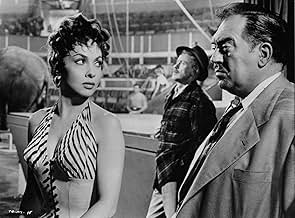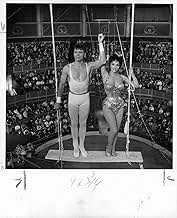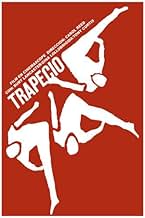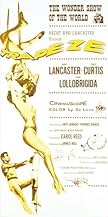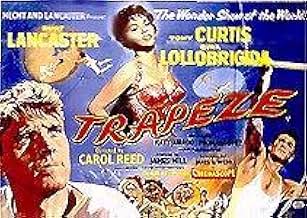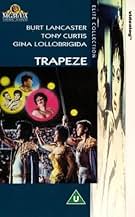IMDb-BEWERTUNG
6,8/10
5577
IHRE BEWERTUNG
Ein verkrüppelter Zirkusakrobat ist emotional hin- und hergerissen zwischen zwei ehrgeizigen jungen Trapezkünstlern, einem begabten jungen Amerikaner und einer weniger begabten, aber schönen... Alles lesenEin verkrüppelter Zirkusakrobat ist emotional hin- und hergerissen zwischen zwei ehrgeizigen jungen Trapezkünstlern, einem begabten jungen Amerikaner und einer weniger begabten, aber schönen Italienerin.Ein verkrüppelter Zirkusakrobat ist emotional hin- und hergerissen zwischen zwei ehrgeizigen jungen Trapezkünstlern, einem begabten jungen Amerikaner und einer weniger begabten, aber schönen Italienerin.
- Auszeichnungen
- 3 Gewinne & 2 Nominierungen insgesamt
Johnny Puleo
- Max
- (as John Puleo)
Gérard Landry
- Chikki
- (as Gerard Landry)
Jean-Pierre Kérien
- Otto
- (as Jean-Pierre Kerien)
Serge Bento
- Circus Boy
- (Nicht genannt)
- …
Paul Bonifas
- Paul - Circus Peddler
- (Nicht genannt)
Roland Carey
- Trapeze Artist
- (Nicht genannt)
Empfohlene Bewertungen
Carol Reed was one of Britain's most interesting directors, and perhaps most intriguing about his work is his unique brand of stylised realism, the two conflicting moods astutely and unforgettably blended: the handsome, dream-like snow-storm in 'Odd Man Out (1947)'; the woozy war-torn streets of Vienna in 'The Third Man (1949)'; the blending of fantasy against a working-class London background in 'A Kid for Two Farthings (1955).' With 'Trapeze (1956),' Reed deliberately contrasts his use of fantasy and realism. The circus had long held an element of prestige, having spawned a tidy sub-genre of its own, encompassing everything from Lind's 'The Flying Circus (1912)' to DeMille's 'The Greatest Show on Earth (1952).' For decades, the circus has entertained the masses with daring acts of strength and bravery, dangerous animals and extraordinary human performers. But behind this glamour is a less enchanting side of the circus – endless practice sessions, money-hungry managers, and scheming performers who'd place their own interests before those whose lives are being placed in their hands nightly. 'Trapeze' deals with the collision of these two conflicting worlds.
Mike Ribble (Burt Lancaster) was once a great "flyer" of the trapeze, one of the few men who could execute a triple somersault. However, a tragic accident left him with a permanent limp, and Mike has since lost all interest in the sport he once dominated. That, at least, is until Tino Orsino (Tony Curtis) arrives in Paris, a keen acrobat who seeks Mike's expert instruction. That Ribble eventually agrees to the partnership is, of course, a given, and their ultimate accomplishments are never in any doubt, but the interplay between Lancaster and Curtis is authentic and entertaining. Reed depicts the indomitable circus prestige through audience applause and the cheerful melody of the "Blue Danube" waltz. When the antagonism being played out behind-the-scenes inexorably spills out into the performing arena, both the applause and the music comes to a standstill. Thus, interjecting into this fantasy world comes the realisation that the circus performers are only human. The reality suddenly becomes clear: one mistake will spell almost certain death.
Though Mike and Tino make a formidable team, a romantic complication arises in Lola (Gina Lollobrigida), an ambitious acrobat who'd betray her friends and promise love to anybody whom she thought could aid her career. Lola's exploits are contemptible throughout the film, garnering little sympathy from the audience; one might even suggest that the beating she receives at the hands of her former partners is almost justified by her actions. In any case, the film's conclusion is far too kind to her. Lola chases Mike down a quiet Paris street, perhaps a complementary allusion to Holly Martin's shameful snubbing in the final moments of 'The Third Man (1949).' Maintaining the optimism that Reed displayed previously in 'A Kid for Two Farthings,' this ending offers redemption rather than disgrace to Lola, who is seen to have betrayed her companions, much as Martins betrayed Harry Lime and Anna Schmidt. Most impressive of all is Robert Krasker's creative photography, frequently offering the audience a breathtaking "birds-eye" view of the trapeze routines, like leaning over a precipice into open space.
Mike Ribble (Burt Lancaster) was once a great "flyer" of the trapeze, one of the few men who could execute a triple somersault. However, a tragic accident left him with a permanent limp, and Mike has since lost all interest in the sport he once dominated. That, at least, is until Tino Orsino (Tony Curtis) arrives in Paris, a keen acrobat who seeks Mike's expert instruction. That Ribble eventually agrees to the partnership is, of course, a given, and their ultimate accomplishments are never in any doubt, but the interplay between Lancaster and Curtis is authentic and entertaining. Reed depicts the indomitable circus prestige through audience applause and the cheerful melody of the "Blue Danube" waltz. When the antagonism being played out behind-the-scenes inexorably spills out into the performing arena, both the applause and the music comes to a standstill. Thus, interjecting into this fantasy world comes the realisation that the circus performers are only human. The reality suddenly becomes clear: one mistake will spell almost certain death.
Though Mike and Tino make a formidable team, a romantic complication arises in Lola (Gina Lollobrigida), an ambitious acrobat who'd betray her friends and promise love to anybody whom she thought could aid her career. Lola's exploits are contemptible throughout the film, garnering little sympathy from the audience; one might even suggest that the beating she receives at the hands of her former partners is almost justified by her actions. In any case, the film's conclusion is far too kind to her. Lola chases Mike down a quiet Paris street, perhaps a complementary allusion to Holly Martin's shameful snubbing in the final moments of 'The Third Man (1949).' Maintaining the optimism that Reed displayed previously in 'A Kid for Two Farthings,' this ending offers redemption rather than disgrace to Lola, who is seen to have betrayed her companions, much as Martins betrayed Harry Lime and Anna Schmidt. Most impressive of all is Robert Krasker's creative photography, frequently offering the audience a breathtaking "birds-eye" view of the trapeze routines, like leaning over a precipice into open space.
Burt Lancaster, Tony Curtis and Gina Lollabrigida star in "Trapeze," a 1956 film directed by Carol Reed and also starring Katy Jurado, Thomas Gomez and Johnny Puleo. Lancaster plays a former trapeze artist turned rigger, Mike Ribble, working in a Paris circus. A once great artist, he is grounded due to a permanent injury while doing his famous triple. He is approached by Tino Orsini (Tony Curtis), a talented aerialist who wants to learn the triple. Ribble sees the man's talent immediately, takes him on, and agrees to be his "grabber," the man who catches him mid-air. Problem arise when the beautiful, seductive user Lola (Gina Lollabrigida) who plays both men in order to be part of the act.
Director Reed gives the viewer the vivid experience of working in the circus and the resulting pressure cooker of relationships. The trapeze work is glorious, and there is plenty of it.
Lancaster has the major role, and he gives an excellent performance as a man with no illusions who, through Tino, dares to dream again. His muscular build is shown to great advantage as well. Curtis is excellent as the young, ambitious Tino who falls hard for Lola. Lollabrigida is gorgeous and sexy as the alluring Lola - she does a good job, but really, all she has to do is stand there and she IS the role. The supporting cast is solid, including Katy Jurado as an ex-girlfriend of Mike's and Thomas Gomez as the owner of the circus.
I don't have any figures, but I suspect this film was a big hit. It led to another Lancaster-Curtis collaboration, Sweet Smell of Success, so for that reason alone, it would be worth it. However, Trapeze flies on its own merits.
Director Reed gives the viewer the vivid experience of working in the circus and the resulting pressure cooker of relationships. The trapeze work is glorious, and there is plenty of it.
Lancaster has the major role, and he gives an excellent performance as a man with no illusions who, through Tino, dares to dream again. His muscular build is shown to great advantage as well. Curtis is excellent as the young, ambitious Tino who falls hard for Lola. Lollabrigida is gorgeous and sexy as the alluring Lola - she does a good job, but really, all she has to do is stand there and she IS the role. The supporting cast is solid, including Katy Jurado as an ex-girlfriend of Mike's and Thomas Gomez as the owner of the circus.
I don't have any figures, but I suspect this film was a big hit. It led to another Lancaster-Curtis collaboration, Sweet Smell of Success, so for that reason alone, it would be worth it. However, Trapeze flies on its own merits.
Curtis was young...Lancaster was in his prime.....The trapeze performances were stunning and despite the predictability of the story, Trapeze was a wonderful movie. Though a little "hokey" at times, and dated perhaps today, the warmth, sincerity, and circus-realism makes this a mild classic!
Actually I think Trapeze is a fairly decent depiction of a 1950s European flyer's act. And I understand that Mr. Lancaster was an acrobat whose career was ended due to injury prior to his becoming an actor. So this may have enabled him to have a good feel for his role.
But I'm also a bit biased. I've been to a couple of circuses in Paris, which seemed to mirror the film's atmosphere and I actually met the actors who starred in this film.
In 1955 I was living on an American military base near Paris where Trapeze was being filmed. The USO hosted a gathering on base and Tony Curtis and Gina Lollabrigida appeared to promote the film and sign autographs. My older sisters got their photos taken with Mr. Curtis.
So naturally, whenever I catch this film on late night cable, I see it from a nostalgic point of view.
But I'm also a bit biased. I've been to a couple of circuses in Paris, which seemed to mirror the film's atmosphere and I actually met the actors who starred in this film.
In 1955 I was living on an American military base near Paris where Trapeze was being filmed. The USO hosted a gathering on base and Tony Curtis and Gina Lollabrigida appeared to promote the film and sign autographs. My older sisters got their photos taken with Mr. Curtis.
So naturally, whenever I catch this film on late night cable, I see it from a nostalgic point of view.
Burt Lancaster, Tony Curtis, and Gina Lollbrigida star in "Trapeze," which depicts the life of trapeze artists in a circus. Tony Curtis wants to be a great trapeze artist and thinks he's ready for it, except for one thing, the triple somersault. And, he needs Burt Lancaster to teach him. But, Burt has quit the spotlight since he tried the triple and fell. But, when he sees Tony and what he can do, he thinks Tony can do a triple. But, he won't tell him so, at first. Enter Gina. She has a wire act of her own, and she want to get in on the main attraction. And, of course, love enters the picture.
This may have a why should I care? feel to it, as it may not interest some people at all. But for those who will be watching for the stars, the rewards are many. This is a more personal and realistic (of course how should I know) story and treatment of what goes on beyond the high wire act than Cecil B. DeMille's "The Greatest Show on Earth." We are allowed to see beyond the glamorous lifestyle and see them as people who are trying to express themselves while existing here on this earth. This has a deep respect for its subject matter and its characters and shows how they have to work together in order for the act to work, and not just because of the obvious physical risks involved but because they are supposed to be a team and not looking out only for themselves.
Plus, Lancaster apparently had some experience in this and performed most of his stunts, and, after Tony and Gina practiced a lot, they did as much as they could. So you do get the real thing and some really good and sincere performances.
If you want less DeMille-like glitz and more substance, then this is the circus for you.
This may have a why should I care? feel to it, as it may not interest some people at all. But for those who will be watching for the stars, the rewards are many. This is a more personal and realistic (of course how should I know) story and treatment of what goes on beyond the high wire act than Cecil B. DeMille's "The Greatest Show on Earth." We are allowed to see beyond the glamorous lifestyle and see them as people who are trying to express themselves while existing here on this earth. This has a deep respect for its subject matter and its characters and shows how they have to work together in order for the act to work, and not just because of the obvious physical risks involved but because they are supposed to be a team and not looking out only for themselves.
Plus, Lancaster apparently had some experience in this and performed most of his stunts, and, after Tony and Gina practiced a lot, they did as much as they could. So you do get the real thing and some really good and sincere performances.
If you want less DeMille-like glitz and more substance, then this is the circus for you.
Wusstest du schon
- WissenswertesThe 41-year-old Burt Lancaster performed all but one of the trapeze stunts himself, having worked in a circus before entering films. He insisted on doing the climactic triple somersault, but technical adviser Eddie Ward initially was hesitant on Lancaster performing the stunt, and Ward doubled for him during the first weeks of shooting. Director Sir Carol Reed eventually hired Lancaster's longtime friend, stuntman Nick Cravat to perform the stunt.
- Zitate
Tino Orsini: You know, I always modeled my style after yours.
Mike Ribble: You'll always be a second-rater. Make your own style!
- VerbindungenFeatured in 101 Nacht - Die Träume des M. Cinema (1995)
- SoundtracksThe Blue Danube (An der schönen, blauen Donau, Op. 314)
(uncredited)
Music by Johann Strauss
Played during the trapeze routines
Top-Auswahl
Melde dich zum Bewerten an und greife auf die Watchlist für personalisierte Empfehlungen zu.
- How long is Trapeze?Powered by Alexa
Details
- Erscheinungsdatum
- Herkunftsland
- Sprachen
- Auch bekannt als
- Trapeze
- Drehorte
- Cirque d'Hiver - 110 rue Amelot, Paris 11, Paris, Frankreich(picture photographed at)
- Produktionsfirmen
- Weitere beteiligte Unternehmen bei IMDbPro anzeigen
Box Office
- Budget
- 4.000.000 $ (geschätzt)
- Laufzeit1 Stunde 45 Minuten
- Farbe
- Seitenverhältnis
- 2.35 : 1
Zu dieser Seite beitragen
Bearbeitung vorschlagen oder fehlenden Inhalt hinzufügen



